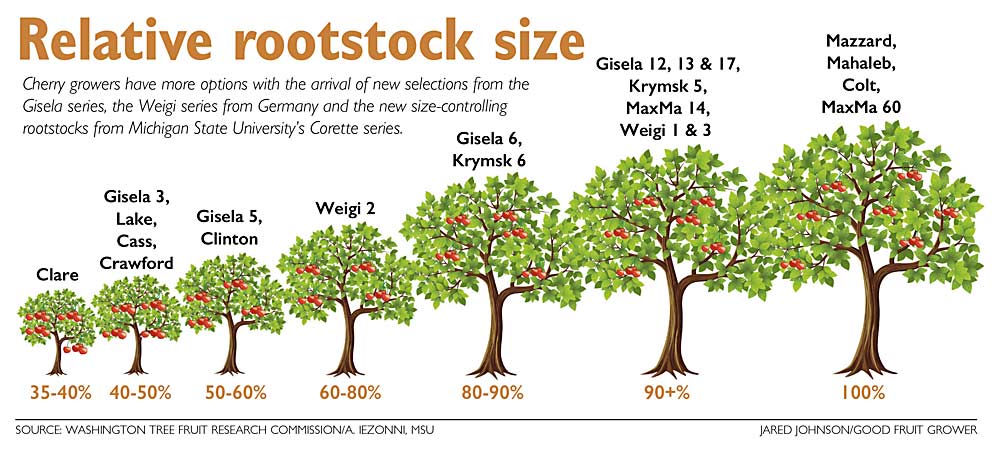When it comes to rootstocks, cherry growers are about to get a lot more choices.

Lynn Long
There are no perfect options, so what to consider depends on what you need in a rootstock, said horticulturist Lynn Long, who recently retired from Oregon State University. He gave a rundown of the benefits and drawbacks of about a dozen new or soon-to-be-available rootstocks at the Cherry Fruit School in March, an educational event run by Washington State University and OSU.
Promising newcomers include new members of the Gisela series adapted to performing in poorer soils, precocious rootstocks from the Weigi series that are performing well in Europe, and the new size-controlling rootstocks from Michigan State University’s Corette series.
Long based his talk on the traits that growers report wanting from rootstocks:
—Increased productivity of some cultivars.
—Moderate oversetting of other cultivars.
—Precocity and consistent fruit set without compromising fruit size.
—Size control.
—Precocity with vigor.
—Precocious, size-controlling options for poorer soils.
—Disease resistance.
Today, growers have strong options for precocity with vigor, including commonly used Gisela 6 and 12, Krymsk 5 and 6, MaxMa 14, and newcomers Gisela 13 and 17, and Weigi 1 and 3, Long said. His trials show that Krymsk 5 and 6 and MM14 moderate the oversetting potential of cultivars such as Chelan and Sweetheart and maintain good fruit size.
When it comes to precocity with size control, growers haven’t had many options until now.
Interested growers should plant trials with the Corette series, Long said. Named for Michigan counties, Clinton is the largest, similar in size to Gi.5, while Lake, Cass and Crawford are slightly smaller and Clare is the smallest, about 40 percent of a standard tree on Mazzard.
The new rootstocks have been released with a volume restriction so that growers can test them on a limited basis as the industry learns more about how to grow high-density cherries.

Cherry growers have more options with the arrival of new selections from the Gisela series, the Weigi series from Germany and the new size-controlling rootstocks from Michigan State University’s Corette series. (Jared Johnson/Good Fruit Grower Illustration)
Long shared data from his recent trials with Regina that showed good yields of 9.2 tons per acre on Cass and 8.8 tons per acre on Clinton, although he cautioned that he only has one year of data so far.
“We can say there are going to be some options in the future for precocity with size control with these rootstocks,” he said.
One of the Weigi rootstocks, Weigi 2, also appears to provide good precocity with size control, according to data Long shared from trials at a French research station located in the Provence region, which has a similar climate to the Pacific Northwest, he said.
Developed in Germany, the series comes from a cross between Weiroot and Gisela, he said, and Oregon nursery Tree Connection plans to market it in the U.S. in coming years.
Growers who are looking for good precocity but also a more forgiving rootstock in terms of fruit set and size, similar to modern apple roots, might find winners in the Weigi series, Long said.
“When we look at yield, we see the yield is much higher on the Weigi 1 and 3; these are bigger trees,” he said. “Fruit size is excellent with Regina across all the rootstocks.”
Growers with poorer soils will soon have options for precocious rootstocks with new releases from the Gisela program, Long said. Gi.13 offers a similar size to Gi.6 but with good yields and good fruit quality under less favorable conditions. Gi.17 offers more vigor and sizing at about 70 to 80 percent of Mazzard, but it’s much more precocious, Long said.
“What they say is that it has less potential for overcropping, so you can combine it with some of the more productive cultivars,” he said.
Trials with Bing on Gi.17 in Prosser, Washington, and Summerland, British Columbia, where soils are poorer, show yields in between Gi.5 and Gi.6.
Lastly, Long discussed the possibility of using rootstocks to convey tolerance to disease.
“All of the growers I talked to said we need disease resistance through our rootstocks,” he said, with bacterial canker being at the top of the list.
There is evidence that rootstocks can provide tolerance to bacterial canker: Bing grown on Colt had much better survival after bacterial canker inoculation in an OSU study. In the same study, precocious Krymsk 5 had more moderate susceptibility, similar to Mazzard, but much lower mortality than Gi.6, Long said. He’s also heard anecdotal reports from growers in Chile that MaxMa 5 has relatively lower disease risk as well.
As for resistance to the latest viral threats, little cherry virus and Western X, there’s no research yet. There are rootstocks that show tolerance to other viruses, but that is a double-edged sword, Long cautioned, since infected trees that don’t show symptoms can still spread the disease to other susceptible trees.
“Resistance is an excellent trait we’d like to have,” he added. •
—by Kate Prengaman






Leave A Comment